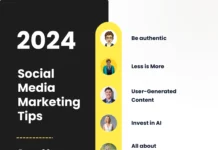
Ensuring that your business has a presence on social media is non-negotiable in this day and age. But growing your social media accounts organically is not an easy feat and it can take a long time to grow your user base and account activity if you stick to strictly orthodox methods. That’s why more and more marketers are using social media proxies.
But what are social media proxies?
In order to understand this, we first have to understand the difference between the main types of proxies.
Data Center, Residential, and Mobile Proxies
Technically, you could use any of these proxies as social media proxies, but in the case of data center proxies, it really isn’t a good idea.
Data center proxies are a group of remote servers you can connect to if you need to hide your IP for various reasons. These servers are not connected to an Internet Service Provider (ISP), therefore allowing you to not be linked to one particular place, and giving you complete anonymity and privacy. When it comes to your social media accounts, however, it’s advisable not to use a data center proxy — even though you might be tempted by the better speed and much lower prices — because they are usually shared and you won’t know who else logged in with that IP or how “dirty” it is in the eyes of Instagram, for example. You could try using a private data center proxy, which has a clean history, but you have to keep in mind it’s not natural to log onto social media from the type of IP belonging to a data center, so it might raise red flags sooner or later, and you risk having your accounts blocked.
Unlike data center proxies that use an IP provided by the data center, residential proxies use the default IP address assigned by the ISP of a residential location. This means that when you use a residential proxy, your requests appear to be coming from a regular home connection, either from a PC or laptop connected through a residential IP, or a mobile device connected to a home Wi-Fi. Needless to say, this makes the proxy appear very legitimate and trustworthy, like it’s just a regular account used by a real user. Of course, like with every other type of proxy, it’s best to go as secure as you can. Your best option is a virgin residential proxy, which hasn’t been used by anyone before, so you don’t risk having your accounts or proxy blocked because of a contaminated IP.
Mobile proxies are in a way similar to residential proxies, in that they are also connected through an ISP. The only real difference is that mobile proxies are connected through a 4G mobile ISP. Because they use mobile IP addresses, which change constantly (like when you’re on the go), websites treat requests routed through them as requests coming from mobile devices. Obviously, this is ideal when it comes to managing social media accounts, because most users access social media through their smartphones, and social media platforms rarely block an account that seems to be coming from a mobile device with normal activity.
Both residential and mobile proxies can be acquired for dedicated social media networks, such as Instagram, Facebook, Twitter, etc. This means that if you buy a dedicated private proxy for Pinterest, you will be the only user of that IP, or at least you will be the only user using that IP for Pinterest, even if the seller decides to sell that same IP to someone else to use exclusively on Instagram. The bottom line is that one user will not use the same IP for different social media networks. If you’re interested specifically in learning how to use a proxy for Pinterest, check out this guide on Pinterest proxies. It has step-by-step information you can follow if you don’t want to dabble too much in the not-so-easy-to-grasp proxy theory.
Ok, now that we’ve learned a little bit about the different types of proxies, let’s see how social media proxies can help marketers.
How Marketers Can Use Social Media Proxies in 2022
I believe social media proxies are invaluable to marketers in 2022. With the ability to create and manage multiple social media accounts that point to one main account, marketers can now reach a much larger audience. For example, the marketer can post original content on the main account, while the other proxy accounts interact with this original content and share it with their audience.
The truth is there are many things that marketers can accomplish with the help of a social media proxy, but let’s take a look at a few of the most important ones:
Automation
Social media marketers know the importance of growing your account quickly, that’s why many of them use proxies to create multiple social media accounts that can interact with the main business account — liking, sharing, and commenting on posts to boost the visibility and popularity of the main account. But this is exhausting and takes a lot of time, that’s why many marketers also turn to automation tools or bots that can automatically perform all the usual account activities like liking, sharing, commenting, following, unfollowing, or sending direct messages.
The problem is that these bots are frequently caught by social media platforms, which have strict terms and services against spam, and it’s hard to regain an account once it’s been banned. This is especially problematic if you’re a social media agency handling multiple client accounts. That’s why it is essential for marketers to also use social media proxies whenever they choose to use bots.
The main problem with bots is that they perform tasks much faster than a normal human would, which naturally draws attention. With proxies that use different IPs, each request will give the impression it’s sent from a completely different location, which takes the target off the bot’s back.
Still, even with proxies, it’s good to follow a few principles when it comes to automation:
- Don’t take too many actions at once.
- If you’re performing repetitive actions, start slow and increase speed gradually.
- Try to act naturally. Don’t do the same 2-3 actions on repeat; instead, try to repeat more actions and have a more complex automatization, or log into the account more frequently and behave naturally: check the feed, check the messages, scroll, like, comment, don’t just exclusively send messages, for instance.
Social Media Agencies
Aside from marketers, the other big users of social media proxies are PR and social agencies. Handling a single business account with multiple secondary accounts through proxy sounds complicated enough, but try to scale that to 10-15 clients or more.
Social media agencies manage their clients’ social media accounts, and doing that from one single IP or network would be right-on suicidal. Therefore, they must use private proxies to handle their clients’ social media. But when you’re a social media agency, having proxies to manage your social media accounts is not enough, you also need tools to manage your proxies, which brings us to our next chapter:
Tools for Proxies
The default to using a proxy is through a web browser, but that is not enough for automation or social media management. You need a dedicated tool that can basically isolate all the information pertaining to an account for every account you have open. There are social media tools that allow marketers to manage a large number of social media accounts by connecting them through proxies, and simultaneously manage multiple social media accounts from the same server.
In addition, you would also need a virtual private server to be able to constantly run this social media proxy tool. This is because your social media accounts may be based in different time zones depending on your actual clients, so you can’t just turn off everything when you’re sleeping. It might be the middle of the day for a client in a different part of the world. Furthermore, each account has to do its own thing, and they may run simultaneously, so it’s not realistic to keep them on your personal computer, as they’re a significant strain on your PC’s resources.
Brand Awareness
There is no doubt that using multiple accounts will lead to increased brand awareness. Not only can your secondary accounts promote your products or services, but they can also engage in online discussions about your products or services and talk about how they can fix certain issues or meet different needs. This can in turn not only increase activity and followers on your social media but traffic to your website as well, as more and more people show up to check out your great products and find out more about you.
Keep in mind, though, your newly gained customers need to land on something good in order to stay and spread the word. While using secondary social media proxy accounts to interact with your followers is a great way to bring in new customers, you have to be aware that these secondary accounts are not your actual followers, and any efforts to bring in new followers would be in vain if they have nothing interesting to stay for. So keep your content interesting and valuable, and when those real users end up on your account, they will want to start following you.
Competitor Research
Having a good product to market is the first key to success, but it’s tough to manage without keeping an eye on your competitors. To stay on top of your game, you need to be aware of your competition and what they’re doing, what products they’re launching, what their content looks like, and how they’re reviewed by their users.
Proxies can help you do that by hiding your identity so that your competitors don’t block you. They’re especially good for monitoring competitors’ ads and organic rankings. Unlike in other cases where it’s best to use mobile or residential proxies, in this situation using data center proxies could be enough. However, if you’re dealing with a highly competitive field, you should be more thorough, because the competition could exclude hugely popular and public proxies from their ad campaigns, in which case a private and lesser-known IP would be more suitable. Moreover, if you’d like to see your competitor’s mobile ads, a mobile proxy would be the most suitable choice. These would allow you to visualize not only mobile ads, which can be different from desktop ads, but also organic ranking results, which can differ as well.
But I’d like to give you a more concrete example of how social media proxies might help with competitor research. For example, you notice that you haven’t had sales for a while in a certain location, let’s say Oxford. You can buy a mobile proxy from Oxford and take a look at what’s happening in organic results on Google or in Google ads. You might notice that a competitor has launched an aggressive campaign with huge discounts and they’re stealing all your customers. Without a local proxy, you wouldn’t be able to catch this, because you’d only be looking at a national level and have no idea what’s going on in Oxford.
Conclusion
These are just a few of the interesting things marketers can do with proxies on modern social media platforms. If you’re planning to take any of these steps, make sure you look for quality, because here it’s really important.











